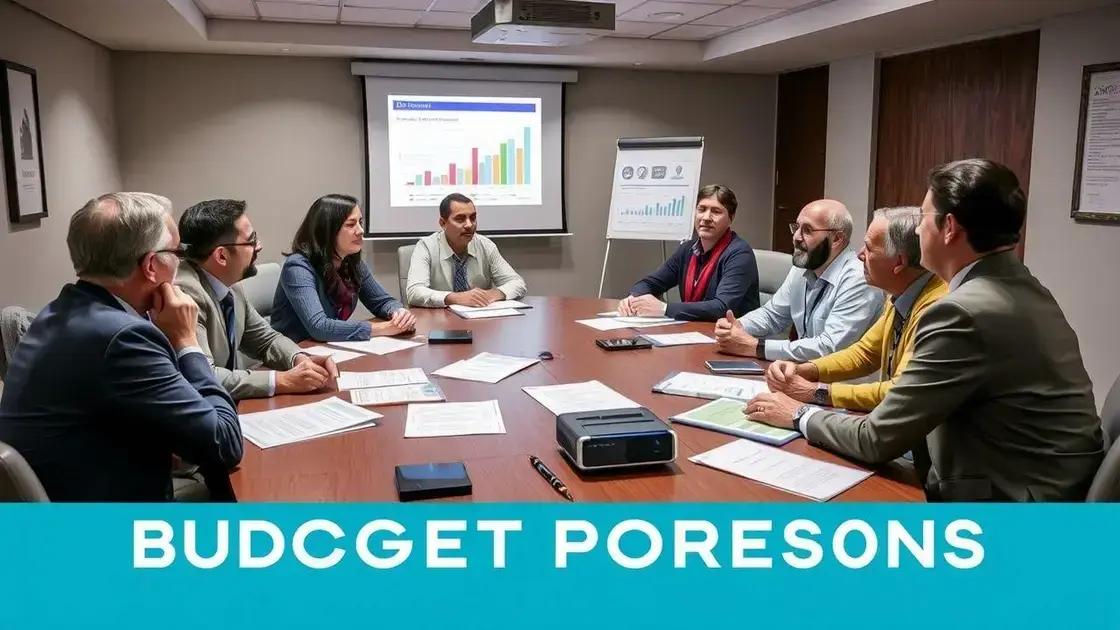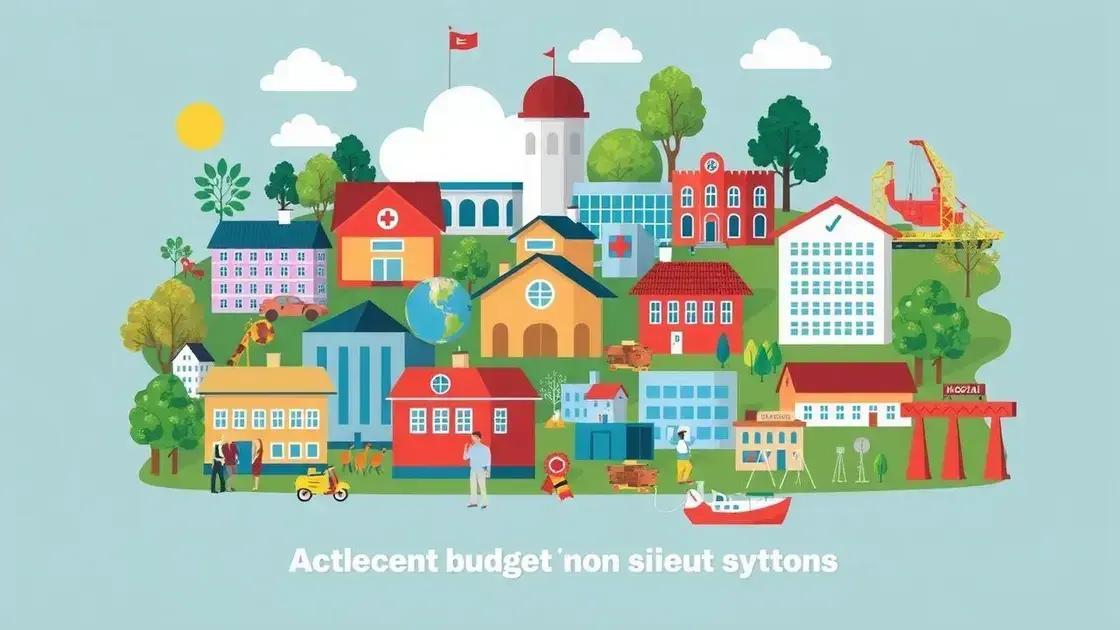Federal budget negotiations: what you need to know

Federal budget negotiations determine how taxpayer funds are allocated to essential services like education and healthcare, impacted by political divisions, economic constraints, and interest group pressures.
Federal budget negotiations can often feel distant, yet they impact our daily lives significantly. How much do you really know about this process? Let’s dive in and explore its complexities.
Understanding federal budget negotiations
Understanding federal budget negotiations is essential for grasping how government funding decisions are made. These negotiations determine how taxpayer dollars are allocated, impacting everything from healthcare to education.
The Basics of Federal Budget Negotiations
Every year, the federal government goes through a complex budgeting process. This process involves multiple steps and key players. The president proposes a budget, which Congress reviews, amends, and ultimately approves or rejects.
Key Players
The major participants in budget negotiations include:
- Congressional committees, which analyze the proposed budget.
- The president, who sets the initial budget priorities.
- Interest groups advocating for specific funding areas.
Each of these players plays a critical role in shaping how federal funds are distributed. Their negotiations can often lead to compromises that influence various sectors.
Additionally, public opinion can sway these negotiations. When people express concern over issues like healthcare or education, lawmakers may prioritize funding in those areas. This participation helps keep the budget aligned with the public’s needs.
Challenges in Budget Negotiations
Budget negotiations are often fraught with challenges. Some common hurdles include:
- Disagreements among political parties.
- Economic downturns affecting available funds.
- Pressure from lobbyists for special interests.
These factors can complicate the already intricate process, leading to last-minute deals or government shutdowns.
In essence, understanding federal budget negotiations requires looking at the interplay between various entities and the effects of public sentiment. As citizens, staying informed can empower you to engage in this vital process.
Key players in budget negotiations

In the realm of federal budget negotiations, understanding the key players involved is crucial for grasping how decisions are made. These individuals and groups influence the process significantly, shaping the direction of funding across various sectors.
The Role of Congress
Congress is a primary actor in budget negotiations. Committees within Congress review the president’s proposed budget. They analyze it line by line, debating its merits and suggesting revisions. This rigorous examination is vital, as it ensures that various interests are represented.
The President’s Influence
The president begins the process by presenting a budget proposal. This proposal outlines funding priorities for the upcoming fiscal year. The president’s administration works hard to advocate for specific initiatives, often mobilizing support to secure necessary funding.
Special Interest Groups
Special interest groups also play an important role in shaping budget negotiations. They represent various sectors such as healthcare, education, and defense. These groups often lobby Congress and the executive branch, pushing for funding that aligns with their goals.
- Advocating for public health funding
- Campaigning for education resources
- Lobbying for infrastructure improvements
Public opinion can influence these players as well. When citizens voice their concerns about specific issues, lawmakers may feel pressured to adjust their negotiation strategies to reflect the electorate’s priorities.
Ultimately, the interplay between these key players creates a dynamic environment during federal budget negotiations. Collaboration and conflict are constant as they work to balance competing interests and achieve sustainable funding solutions.
Timeline of the federal budget process
The timeline of the federal budget process outlines the key steps taken each year to create a budget that funds government operations. Understanding this timeline can help citizens become more aware of how their tax dollars are allocated.
Budget Proposal Phase
The process begins in February when the president submits the budget proposal to Congress. This document details funding priorities and is created with input from various agencies, aiming to set the stage for negotiations.
Congressional Review
Following the proposal, Congress holds hearings to review the budget. This happens from February through May, during which congressional committees question officials about funding needs. These discussions help prioritize areas of importance.
- Health and human services
- Defense and security
- Education funding
The committees then draft their own budget resolutions by April. These resolutions lay out spending limits and help guide the work of appropriators.
Appropriations Process
From May to September, Congress works on appropriations bills. These bills allocate specific amounts of money to various government departments and programs. Each bill must be passed by both the House and Senate before being signed by the president.
Finalization and Implementation
If Congress does not pass the budget by October 1, the start of the new fiscal year, temporary funding measures called continuing resolutions may be enacted. These maintain government operations until a full budget is approved. This can lead to last-minute negotiations and often results in budget cuts or adjustments.
Once the budget is finalized, agencies can implement their plans and allocate resources as needed. Overall, the timeline of the federal budget process is essential to ensure that government funding aligns with national priorities and needs.
Impacts of budget negotiations on public services

The impacts of budget negotiations on public services are profound and far-reaching. These negotiations determine how funds are allocated to essential areas such as education, healthcare, and infrastructure. As discussions unfold, the outcomes can significantly affect communities across the nation.
Education Sector
In budget negotiations, education funding often becomes a hot topic. Lawmakers may debate the allocation of money for K-12 schools, state universities, and vocational programs. When budgets are tight, education can face funding cuts, which may lead to larger class sizes and fewer resources for students.
Healthcare Funding
The healthcare system also feels the impacts of budget negotiations. Funding for programs like Medicaid and Medicare can fluctuate based on the outcomes of negotiations. Cuts to these programs can result in limited access to essential health services for low-income individuals and families, further exacerbating health disparities.
- Reduced funding for mental health services
- Increased insurance premiums
- Lack of support for community health initiatives
These consequences highlight the importance of advocating for adequate healthcare funding during negotiations.
Infrastructure Investments
Infrastructure is another critical area affected by budget negotiations. Projects for roads, bridges, and public transportation systems often rely on federal funding. If budget discussions lead to cuts or delays in funding, necessary updates and repairs may be postponed, resulting in aging infrastructure and potential safety hazards.
The overall socioeconomic health of communities hinges on the outcomes of these negotiations. Public services rely heavily on budget allocations, and the impacts are felt in everyday life. Where funding is reduced, the quality of services diminishes, and citizens may face long-term challenges. Therefore, understanding the impacts of budget negotiations on public services is crucial for citizens to advocate effectively for their communities.
Common challenges faced in negotiations
Negotiating the federal budget comes with a variety of challenges that can complicate the process. Understanding these common challenges faced in negotiations can provide insight into why budget discussions often take longer than expected and may result in conflicts between parties.
Political Divisions
One major challenge is political division. Different parties often have conflicting priorities, which can lead to gridlock. For example, while one party may prioritize spending on social services, another may focus on tax cuts or defense spending. These differences can stall negotiations as both sides work to find common ground.
Economic Constraints
The economy also plays a significant role in budget negotiations. During economic downturns, there is often less revenue available, which means tough choices must be made. Lawmakers may have to decide between cutting programs or increasing taxes, both of which can be contentious issues.
- Reduced funding for public services
- Debates over tax increases
- Pressure to balance the budget
This environment can create a tense atmosphere as parties vie for limited resources.
Interest Group Pressure
Another challenge involves pressure from interest groups. Many organizations lobby for specific funding allocations or policy changes that align with their goals. This lobbying can complicate negotiations as lawmakers attempt to satisfy various stakeholders while also considering the needs of their constituents.
As a result, negotiations can become bogged down, with competing interests influencing the discussions. Navigating these pressures requires skill and often leads to compromises that may not fully meet anyone’s expectations.
Consequently, understanding the common challenges faced in negotiations is crucial for anyone interested in how federal budget decisions are made. Awareness of these factors helps illuminate the complexities involved in reaching a consensus.
Future of federal budget planning

The future of federal budget planning holds a host of possibilities shaped by ongoing economic trends, technological advances, and changing political landscapes. As society evolves, so too must the way we plan and allocate federal funds.
Emphasis on Fiscal Responsibility
One trend that is likely to continue is the emphasis on fiscal responsibility. Lawmakers are becoming increasingly aware of the need to balance budgets and avoid excessive debt. This focus can lead to more conservative spending patterns and increased scrutiny over budget proposals.
Integration of Technology
Technology is also poised to play a major role in shaping the future of federal budget planning. Advanced data analytics can improve decision-making processes by providing lawmakers with insights into the most effective allocations of resources. Technologies like artificial intelligence can help predict outcomes and optimize budgeting strategies.
- Improved data transparency
- Enhanced tracking of expenditures
- Automated reporting processes
These advancements can lead to more informed and efficient budget decisions across various sectors.
Public Engagement and Accountability
Engaging the public in budget planning may become more prevalent. As citizens demand greater transparency and accountability, there could be more opportunities for public input in the budgeting process. This can encourage a greater sense of ownership and responsibility among taxpayers.
Legislators might adopt new platforms for feedback and discussions, allowing citizens to voice their concerns and priorities. Such approaches could lead to budgets that reflect the actual needs and aspirations of the public, fostering stronger communities.
Overall, the future of federal budget planning looks to be more adaptive and responsive to the evolving challenges and expectations of society. By integrating technology, emphasizing fiscal discipline, and enhancing public participation, lawmakers can craft budgets that serve their constituents effectively.
FAQ – Frequently Asked Questions about Federal Budget Negotiations
What are federal budget negotiations?
Federal budget negotiations are discussions among lawmakers to decide how public funds are allocated for various government programs and services.
Why are budget negotiations important?
Budget negotiations are important because they determine how taxpayer money is spent on crucial services like education, healthcare, and infrastructure.
What challenges do lawmakers face during budget negotiations?
Lawmakers face challenges such as political divisions, economic constraints, and pressures from interest groups, which can complicate decision-making.
How can citizens get involved in the budget planning process?
Citizens can get involved by staying informed, voicing their opinions to representatives, and participating in public discussions about budget priorities.






